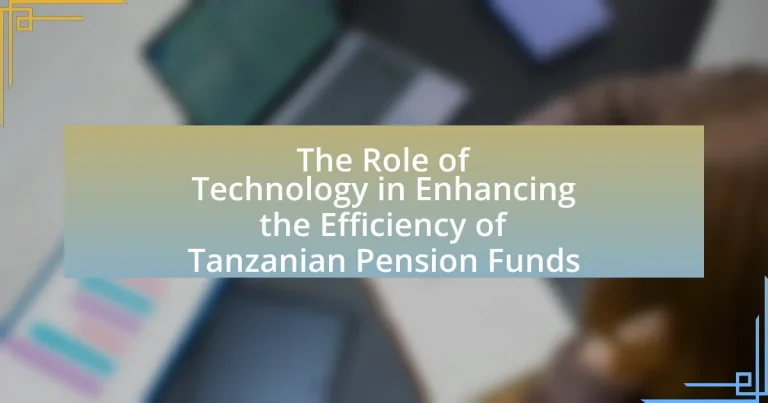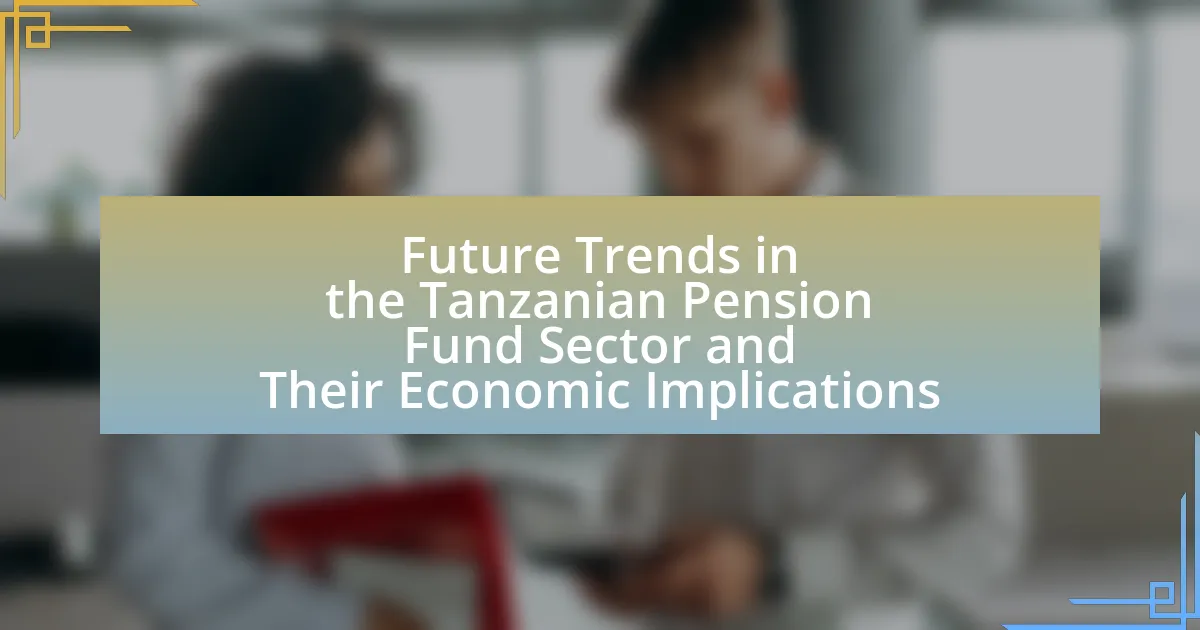The article examines the role of technology in enhancing the efficiency of Tanzanian pension funds. It highlights how digital platforms streamline operations, improve data management, and facilitate communication with stakeholders, leading to reduced administrative costs and increased member engagement. Key technologies utilized include mobile banking, automated investment systems, and data analytics tools, which collectively enhance operational efficiency and investment strategies. The article also addresses the challenges faced by pension funds without technology, the risks associated with outdated systems, and the long-term financial benefits of adopting modern technological solutions. Additionally, it outlines best practices for successful technology integration in pension fund management.
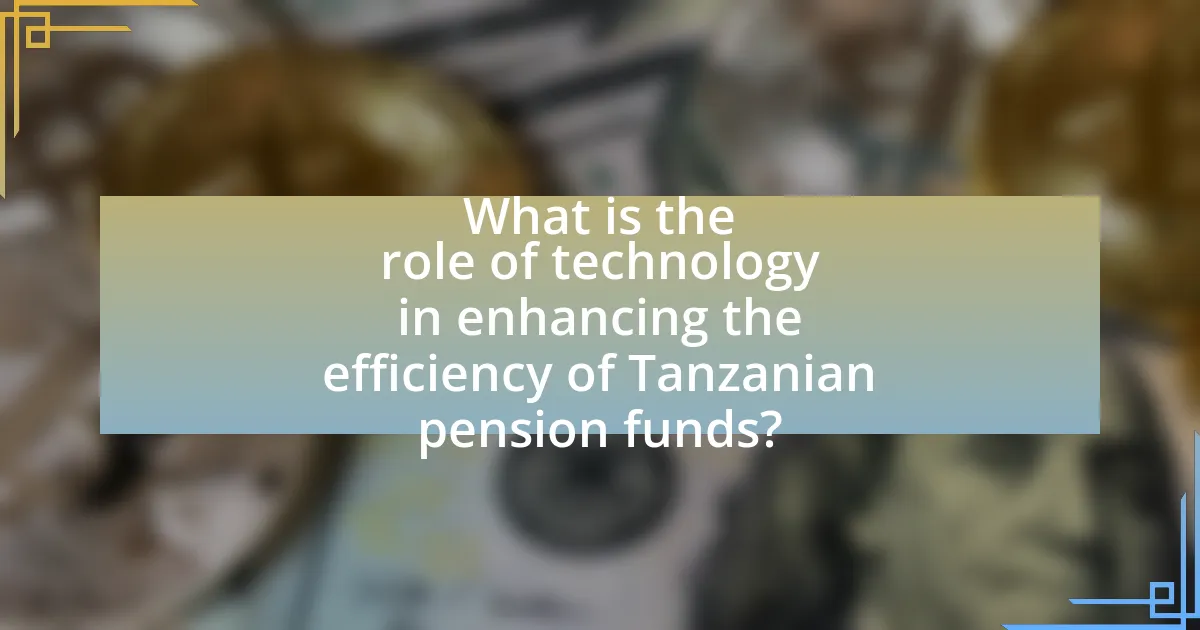
What is the role of technology in enhancing the efficiency of Tanzanian pension funds?
Technology plays a crucial role in enhancing the efficiency of Tanzanian pension funds by streamlining operations, improving data management, and facilitating better communication with stakeholders. The adoption of digital platforms allows for automated processing of contributions and benefits, reducing administrative costs and errors. For instance, the implementation of mobile banking and online portals enables members to access their accounts and make transactions conveniently, which increases member engagement and satisfaction. Additionally, data analytics tools help pension funds assess investment risks and optimize asset allocation, leading to improved financial performance. According to the Bank of Tanzania, the integration of technology in financial services has led to a significant increase in the number of registered pension fund members, indicating enhanced operational efficiency and accessibility.
How does technology impact the management of pension funds in Tanzania?
Technology significantly enhances the management of pension funds in Tanzania by improving data processing, transparency, and accessibility. Digital platforms enable pension fund managers to analyze large datasets efficiently, leading to better investment decisions and risk management. For instance, the adoption of automated systems allows for real-time tracking of fund performance, which increases accountability and reduces operational costs. Additionally, mobile technology facilitates easier access for contributors to monitor their accounts and make informed decisions, thereby increasing participation in pension schemes. The integration of technology in this sector has been supported by the Tanzanian government’s initiatives to promote financial inclusion, which further validates its positive impact on pension fund management.
What specific technologies are being utilized in Tanzanian pension funds?
Tanzanian pension funds are utilizing technologies such as digital platforms for member management, automated investment systems, and data analytics tools. These technologies enhance operational efficiency by streamlining processes, improving data accuracy, and enabling better decision-making. For instance, the use of mobile applications allows members to access their accounts and manage contributions easily, while data analytics helps in assessing investment performance and risk management.
How do these technologies improve operational efficiency?
Technologies improve operational efficiency in Tanzanian pension funds by automating processes, reducing manual errors, and enhancing data management. Automation of routine tasks, such as data entry and transaction processing, allows pension funds to allocate resources more effectively, leading to faster service delivery. For instance, the implementation of digital platforms has been shown to decrease processing times by up to 50%, as reported in a study by the International Labour Organization. Additionally, advanced data analytics enables better decision-making and risk assessment, which further streamlines operations and optimizes fund performance.
What are the challenges faced by Tanzanian pension funds without technology?
Tanzanian pension funds face significant challenges without technology, including inefficiencies in data management and processing. The lack of automated systems leads to delays in transactions and difficulties in tracking contributions and benefits, resulting in poor service delivery to members. Additionally, manual record-keeping increases the risk of errors and fraud, undermining the integrity of the funds. Without technology, pension funds also struggle to analyze investment performance effectively, limiting their ability to make informed decisions that could enhance returns. Furthermore, the absence of digital platforms restricts accessibility for members, hindering their ability to engage with their accounts and receive timely information.
How do traditional methods hinder efficiency in pension fund management?
Traditional methods hinder efficiency in pension fund management by relying on manual processes and outdated technologies that slow down decision-making and increase operational costs. These methods often involve extensive paperwork, which leads to delays in transactions and reporting, ultimately affecting the fund’s responsiveness to market changes. For instance, a study by the World Bank highlights that pension funds using traditional methods face higher administrative costs, which can consume up to 20% of their total assets, thereby reducing overall returns for beneficiaries. Additionally, the lack of real-time data access limits the ability to make informed investment decisions, further compromising the fund’s performance.
What risks are associated with outdated systems in pension funds?
Outdated systems in pension funds pose significant risks, including data security vulnerabilities, inefficiencies in processing transactions, and compliance issues with regulatory standards. These systems often lack modern encryption and cybersecurity measures, making them susceptible to data breaches; for instance, a 2020 report by IBM found that the average cost of a data breach was $3.86 million. Additionally, outdated technology can lead to slow processing times, resulting in delays in benefit payments and increased operational costs. Furthermore, non-compliance with evolving regulations can lead to legal penalties and loss of trust among stakeholders, as highlighted by the 2019 Global Pension Transparency Benchmark, which emphasized the importance of technological adaptability in maintaining compliance.
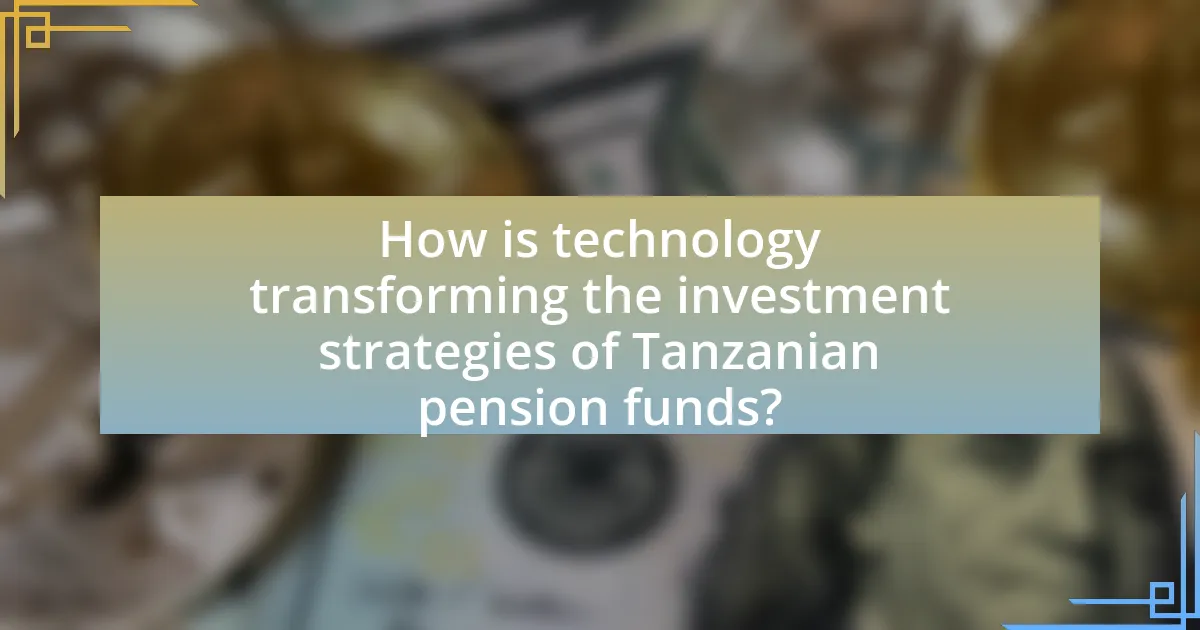
How is technology transforming the investment strategies of Tanzanian pension funds?
Technology is transforming the investment strategies of Tanzanian pension funds by enabling data-driven decision-making and enhancing portfolio management. The integration of advanced analytics and artificial intelligence allows pension funds to assess market trends and risks more accurately, leading to optimized asset allocation. For instance, the use of financial technology platforms facilitates real-time monitoring of investments, which improves responsiveness to market changes. Additionally, blockchain technology is being explored for its potential to enhance transparency and reduce transaction costs in fund management. These technological advancements collectively contribute to more efficient and effective investment strategies for Tanzanian pension funds.
What role does data analytics play in investment decisions?
Data analytics plays a crucial role in investment decisions by enabling investors to analyze vast amounts of financial data to identify trends, assess risks, and optimize portfolio performance. By leveraging data analytics tools, investors can make informed decisions based on quantitative insights rather than intuition alone. For instance, a study by McKinsey & Company found that organizations using advanced analytics in investment strategies can achieve up to 20% higher returns compared to those that do not. This demonstrates that data analytics not only enhances decision-making efficiency but also significantly impacts financial outcomes in investment practices.
How can predictive analytics enhance investment performance?
Predictive analytics can enhance investment performance by utilizing historical data and statistical algorithms to forecast future market trends and asset behaviors. This approach allows investors to make informed decisions based on data-driven insights, reducing uncertainty and improving the likelihood of achieving higher returns. For instance, a study by the CFA Institute found that firms employing predictive analytics in their investment strategies experienced a 20% increase in portfolio performance compared to those that did not. By identifying patterns and anomalies in market data, predictive analytics enables pension funds to optimize asset allocation and risk management, ultimately leading to more efficient investment outcomes.
What tools are available for data analysis in pension fund management?
Data analysis in pension fund management utilizes various tools, including statistical software, data visualization platforms, and financial modeling applications. Tools such as R and Python are widely used for statistical analysis and predictive modeling, enabling fund managers to analyze large datasets effectively. Additionally, platforms like Tableau and Power BI facilitate data visualization, allowing for clearer insights into fund performance and risk assessment. Financial modeling tools, such as Excel and specialized software like MATLAB, support scenario analysis and forecasting, which are crucial for strategic decision-making in pension fund management. These tools collectively enhance the efficiency and effectiveness of managing pension funds by providing accurate data insights and facilitating informed investment strategies.
How does technology facilitate better compliance and regulatory reporting?
Technology facilitates better compliance and regulatory reporting by automating data collection and analysis, which reduces human error and increases accuracy. Automated systems can efficiently gather and process large volumes of data, ensuring that pension funds meet regulatory requirements in a timely manner. For instance, software solutions can track compliance metrics in real-time, allowing for immediate adjustments and reporting. According to a report by Deloitte, organizations that implement technology-driven compliance solutions experience a 30% reduction in compliance costs and a significant decrease in reporting errors. This demonstrates that technology not only streamlines the compliance process but also enhances the overall reliability of regulatory reporting for pension funds.
What are the key compliance challenges for Tanzanian pension funds?
The key compliance challenges for Tanzanian pension funds include regulatory adherence, data management, and transparency. Regulatory adherence is complicated by frequent changes in laws and guidelines, which require pension funds to continuously update their compliance frameworks. Data management poses challenges due to the need for accurate and secure handling of sensitive member information, which is critical for meeting compliance standards. Transparency is essential for building trust with stakeholders, yet many pension funds struggle to provide clear and accessible information regarding their operations and financial health. These challenges are exacerbated by limited technological infrastructure, which hinders efficient compliance processes.
How can technology streamline reporting processes?
Technology can streamline reporting processes by automating data collection and analysis, which reduces manual errors and saves time. For instance, software solutions can integrate with existing databases to gather real-time data, enabling quicker report generation. According to a study by Deloitte, organizations that implement automated reporting tools can reduce reporting time by up to 80%, allowing for more timely decision-making. Additionally, cloud-based platforms facilitate easier access to reports and data sharing among stakeholders, enhancing collaboration and transparency in the reporting process.
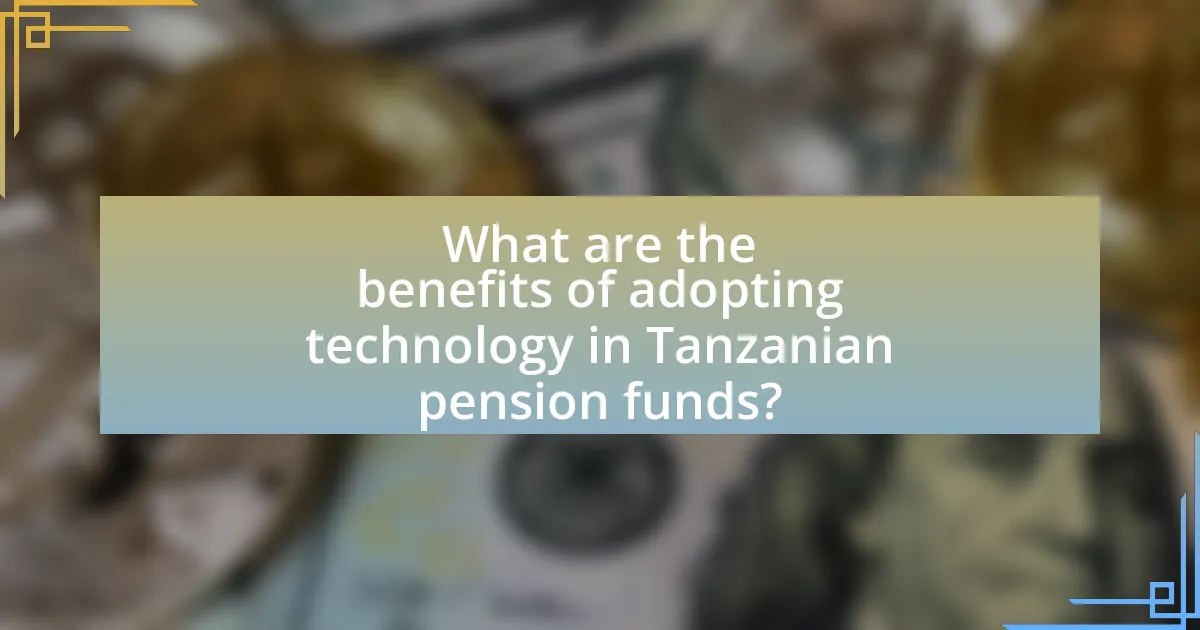
What are the benefits of adopting technology in Tanzanian pension funds?
The benefits of adopting technology in Tanzanian pension funds include improved efficiency, enhanced data management, and better customer service. Technology streamlines operations, allowing pension funds to process transactions faster and reduce administrative costs. For instance, the implementation of digital platforms enables real-time tracking of contributions and benefits, which enhances transparency and accountability. Additionally, advanced data analytics can help pension funds make informed investment decisions, ultimately leading to higher returns for members. According to a report by the International Labour Organization, digitization in financial services can increase access to pension schemes, particularly for underserved populations, thereby promoting financial inclusion.
How does technology improve customer service for pension fund members?
Technology improves customer service for pension fund members by enabling efficient communication, personalized services, and streamlined processes. Digital platforms allow members to access their accounts, view statements, and manage their investments in real-time, enhancing transparency and engagement. For instance, mobile applications and online portals provide 24/7 access to information, reducing wait times and improving member satisfaction. Additionally, automated chatbots and AI-driven customer support can handle inquiries quickly, ensuring that members receive timely assistance. According to a report by the International Labour Organization, the adoption of technology in pension systems can lead to a 30% increase in member satisfaction due to improved service delivery and responsiveness.
What digital platforms enhance member engagement and communication?
Digital platforms that enhance member engagement and communication include social media, mobile applications, and dedicated member portals. Social media platforms like Facebook and Twitter facilitate real-time interaction and updates, allowing pension funds to communicate effectively with members. Mobile applications provide personalized access to account information and services, improving user experience and engagement. Dedicated member portals offer comprehensive resources, including educational materials and forums for discussion, fostering a sense of community among members. These platforms collectively improve communication efficiency and member satisfaction within Tanzanian pension funds.
How can technology provide transparency to pension fund operations?
Technology can provide transparency to pension fund operations by enabling real-time data access and automated reporting systems. These systems allow stakeholders, including fund members and regulators, to monitor fund performance, investment strategies, and financial transactions continuously. For instance, blockchain technology can create immutable records of transactions, ensuring that all activities are verifiable and traceable. Additionally, data analytics tools can generate comprehensive reports that highlight fund performance metrics, compliance with regulations, and risk assessments, thereby fostering accountability. According to a 2021 report by the World Bank, the implementation of digital platforms in pension management has led to increased transparency and trust among beneficiaries, as they can easily access their account information and understand fund operations.
What cost savings can be achieved through technological advancements?
Technological advancements can achieve significant cost savings by automating processes, reducing operational inefficiencies, and minimizing human error. For instance, the implementation of digital platforms in pension fund management can streamline administrative tasks, leading to a reduction in labor costs and processing times. A study by Deloitte found that automation can reduce operational costs by up to 30% in financial services. Additionally, the use of data analytics allows for better investment decision-making, which can enhance returns and reduce costs associated with poor investment choices. These advancements not only lower expenses but also improve overall efficiency in managing pension funds.
How does automation reduce operational costs in pension funds?
Automation reduces operational costs in pension funds by streamlining processes and minimizing manual intervention. By implementing automated systems for tasks such as data entry, transaction processing, and compliance monitoring, pension funds can significantly decrease labor costs and reduce the likelihood of human error. For instance, a study by Deloitte found that automation can lead to a 30% reduction in operational costs by enhancing efficiency and accuracy in financial operations. This reduction in costs allows pension funds to allocate resources more effectively, ultimately improving their overall financial health and service delivery.
What are the long-term financial benefits of investing in technology?
Investing in technology yields long-term financial benefits such as increased operational efficiency, cost reduction, and enhanced decision-making capabilities. For instance, technology can automate processes within pension funds, leading to significant savings in administrative costs. A study by McKinsey & Company found that organizations that adopt advanced technologies can reduce operational costs by up to 30%. Additionally, technology enables better data analytics, allowing pension funds to make informed investment decisions that can improve returns over time. This strategic use of technology not only optimizes resource allocation but also enhances the overall financial performance of pension funds in the long run.
What best practices should Tanzanian pension funds follow when implementing technology?
Tanzanian pension funds should prioritize data security, user training, and regulatory compliance when implementing technology. Ensuring robust data security measures protects sensitive member information from breaches, which is critical given the increasing cyber threats in the financial sector. User training is essential to maximize the effectiveness of new technologies, as well-informed staff can leverage tools efficiently, leading to improved service delivery. Additionally, adhering to regulatory compliance ensures that pension funds meet legal requirements, thereby avoiding penalties and fostering trust among stakeholders. These practices are supported by the growing emphasis on digital transformation in financial services, which highlights the importance of secure and compliant technology adoption.
How can pension funds ensure successful technology integration?
Pension funds can ensure successful technology integration by adopting a structured approach that includes thorough planning, stakeholder engagement, and continuous evaluation. A well-defined strategy that aligns technology initiatives with organizational goals is crucial; for instance, Tanzanian pension funds can benefit from integrating digital platforms that streamline operations and enhance member services. Engaging stakeholders, including employees and beneficiaries, during the integration process fosters acceptance and usability, which is supported by studies showing that user involvement increases technology adoption rates by up to 70%. Continuous evaluation of technology performance through metrics and feedback loops allows pension funds to adapt and optimize their systems, ensuring they meet evolving needs and regulatory requirements.
What common pitfalls should be avoided during technology adoption?
Common pitfalls to avoid during technology adoption include inadequate stakeholder engagement, insufficient training, and lack of a clear strategy. Inadequate stakeholder engagement can lead to resistance and misalignment with organizational goals, as seen in studies where 70% of change initiatives fail due to lack of buy-in. Insufficient training results in underutilization of new technologies, which can hinder operational efficiency; research indicates that organizations that invest in comprehensive training programs see a 30% increase in technology adoption success. Lastly, a lack of a clear strategy can cause confusion and misallocation of resources, as organizations without defined objectives often struggle to measure success and ROI effectively.
